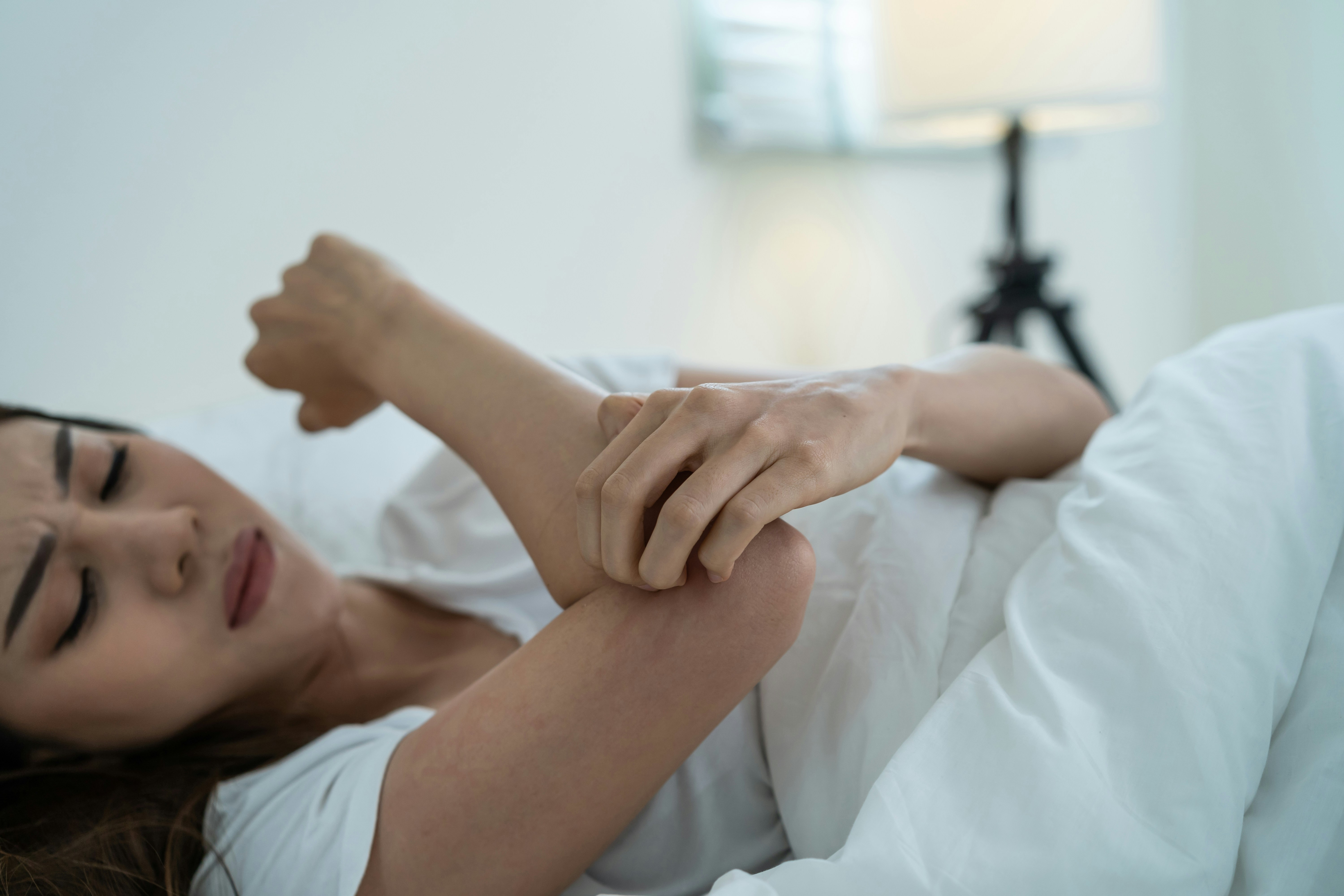That persistent itch isn't in your head, it's perimenopause. 56% of women experience it. Here's why it happens and how to find relief.

That persistent itch isn't in your head, it's perimenopause. 56% of women experience it. Here's why it happens and how to find relief.
If you've suddenly found yourself scratching like you're wearing an invisible wool sweater in July, you're not alone. Research from the Newson Health survey indicates that 56% of perimenopausal women experience itching, with 64% reporting dry skin, yet it's rarely mentioned alongside the more famous symptoms like hot flashes.
That persistent itch keeping you up at night? The dry patches that appeared out of nowhere? The sudden sensitivity to products you've used for years? They're all part of your body's hormonal transformation, and you're definitely not imagining things.
Quick Relief Checklist
Try these evidence-based strategies for immediate comfort:
- Apply a thick moisturizer with ceramides within 3 minutes of bathing
- Switch to lukewarm showers (10 minutes or less)
- Use a humidifier in your bedroom
- Consider an oatmeal bath for acute itching
- Consult a healthcare provider about hormone therapy options
When to see a doctor: If itching disrupts sleep, causes visible rashes, or doesn't improve after 2-3 weeks of consistent self-care.
Understanding the Itch: Why Perimenopause Affects Your Skin
During perimenopause, your body begins a hormonal transformation that affects far more than just your periods. As estrogen levels start their unpredictable decline, your skin, which has estrogen receptors throughout, begins to change in ways that can feel both sudden and frustrating.
The Hormonal Connection
Estrogen plays a crucial role in maintaining healthy skin. This hormone helps:
- Stimulate collagen production to keep skin firm and elastic
- Maintain natural oil production that protects and moisturizes skin
- Support the skin barrier that locks in moisture
- Regulate skin thickness and healing processes
When estrogen levels drop during perimenopause, significant changes occur. Research published in Dermatoendocrinology shows that postmenopausal women can lose up to 30% of their skin collagen in the first five years following menopause, with skin thickness decreasing by 1.13% per year and collagen content declining by 2% annually.
Think of it as your skin losing its protective cushion and moisture-locking abilities all at once.
Why the Itch Happens
Perimenopause itchy skin occurs because of several interconnected factors:
- Decreased moisture retention: Lower estrogen means less hyaluronic acid production, reducing your skin's ability to hold water.
- Compromised skin barrier: The protective layer becomes weaker, allowing irritants in and moisture out.
- Reduced oil production: Less sebum means your skin lacks its natural protective coating.
- Increased sensitivity: Thinner skin becomes more reactive to products, fabrics, and environmental factors.
- pH changes: Hormonal shifts can alter your skin's pH balance, creating an environment prone to irritation.
Studies published in the Journal of the European Academy of Dermatology and Venereology show that these skin changes often coincide with other perimenopause symptoms like night sweats and hot flashes, which can make itching worse, especially at night when your body temperature fluctuates.
Common Areas Affected
Face and Neck
- Dryness around the eyes and mouth
- Increased sensitivity to skincare products
- Flaky patches on cheeks and forehead
- Tightness after cleansing
Arms and Legs
- Rough, sandpaper-like texture
- Visible dryness and flaking
- Increased reaction to shaving or hair removal
- Persistent itchiness, especially on shins and forearms
Perimenopause Itchy Ears: A Surprising Symptom
Some women experience itchy ears during perimenopause as the moisture-producing tissues in the ear canal are also affected by estrogen decline. This lesser-known symptom can be particularly bothersome because the delicate skin in the ear canal is difficult to soothe with topical products.
Other unexpected areas include:
- Scalp (leading to dandruff or sensitivity)
- Between fingers and toes
- Lower back
- Chest area
Treatment Options: Finding Relief from the Itch
The good news? You don't have to suffer through perimenopause itchy skin. Multiple treatment options can help restore comfort.
Moisturizing Strategies
The foundation of treating dry, itchy skin is proper moisturization:
- Timing matters: Apply immediately after bathing while skin is still damp to lock in moisture.
- Choose wisely: Select thick, occlusive moisturizers with ingredients like ceramides, glycerin, and hyaluronic acid.
- Layer properly: Apply products from thinnest to thickest for maximum absorption.
- Don't forget: Often-missed areas like elbows, knees, and feet need attention too.
Hormone Therapy Options
For many women, addressing the root cause, hormonal changes, provides the most comprehensive relief. A 2017 review in Post Reproductive Health notes that menopausal hormone therapy (MHT) is a viable treatment option for perimenopausal women experiencing itching.
Research published in Dermatology demonstrates that estrogen therapy can significantly improve skin texture, hydration, collagen production, and elasticity, all factors that impact itchiness.
Connect with a TwentyEight Health provider to discuss whether hormone therapy might be right for your symptoms. Options include:
- Systemic hormone therapy (pills, patches, or gels)
- Topical estrogen for localized symptoms
- Personalized treatment plans based on your symptom profile
Skincare Adjustments
Your trusted skincare routine might need an overhaul. Consider these changes:
- Switch to gentle, fragrance-free cleansers that won't strip your skin's natural oils.
- Avoid harsh exfoliants that can worsen dryness and irritation.
- Add a hydrating serum with hyaluronic acid to boost moisture retention.
- Use richer night creams to support overnight repair when your skin regenerates.
- Consider face oils for extra moisture barrier support, particularly beneficial for very dry skin types.
Lifestyle Modifications
Small changes can make a big difference:
- Shower in lukewarm water instead of hot
- Limit shower time to 10 minutes or less
- Use a humidifier to add moisture to your environment
- Wear breathable fabrics like cotton and bamboo
- Stay hydrated by drinking plenty of water throughout the day
How to Stop Perimenopause Itching: Prevention Strategies
While you can't completely prevent the hormonal changes of perimenopause, you can minimize their impact on your skin.
Dietary Support
What you eat directly affects your skin health:
- Increase omega-3 fatty acids from fish, walnuts, and flaxseeds to support skin barrier function.
- Load up on antioxidants from colorful fruits and vegetables to combat oxidative stress.
- Stay hydrated with water-rich foods like cucumbers and watermelon.
- Consider collagen-supporting foods like bone broth and vitamin C-rich citrus (though note that evidence for oral collagen supplements remains limited).
Stress Management
Stress can exacerbate skin issues during perimenopause. Try:
- Regular exercise to boost circulation and reduce cortisol
- Meditation or deep breathing exercises for 5-10 minutes daily
- Adequate sleep (7-9 hours nightly) to support skin regeneration
- Activities that bring joy and relaxation to reduce overall stress load
Environmental Protection
Always wear sunscreen as perimenopausal skin is more sun-sensitive, and UV damage can accelerate collagen loss.
Avoid extreme temperatures that can trigger itching and vasodilation.
Choose hypoallergenic laundry detergents free from harsh fragrances and dyes.
Minimize exposure to harsh chemicals in cleaning products, consider natural alternatives.
When Itching Signals Something More
While perimenopause itchy skin is common, persistent or severe itching warrants medical attention.
Seek medical advice if you experience:
- Itching that disrupts sleep or daily activities
- Visible rashes, bumps, or skin changes beyond typical dryness
- Itching accompanied by other concerning symptoms (yellowing skin, unexplained weight changes, extreme fatigue)
- No improvement after 2-3 weeks of consistent self-care
TwentyEight Health providers can help assess your symptoms and determine if additional testing or treatments are needed. Understanding your hormone levels throughout your cycle can provide valuable insights into what's driving your symptoms.
Special Considerations for Different Skin Types
Sensitive Skin
If you've always had reactive skin, perimenopause can amplify sensitivity:
- Patch test all new products on a small area first
- Introduce changes gradually (one new product every 1-2 weeks)
- Focus on barrier-repair ingredients like ceramides and niacinamide
- Avoid known triggers like fragrances, essential oils, and dyes
Dry Skin
Already dry skin needs extra attention during perimenopause:
- Layer multiple hydrating products (essence, serum, moisturizer)
- Use overnight masks regularly (2-3 times per week)
- Consider prescription moisturizers if OTC options aren't sufficient
- Add facial oils to your routine, particularly at night
Combination Skin
Balancing different skin needs becomes trickier during hormonal transitions:
- Use targeted treatments for different areas (lighter on oily zones, heavier on dry patches)
- Adjust products seasonally as your skin's needs change
- Focus on gentle, pH-balanced formulas that won't disrupt your skin barrier
- Monitor how your skin's needs change throughout your cycle
Building Your Perimenopause Skincare Routine
Creating an effective routine doesn't have to be complicated.
Morning Routine:
- Gentle cleanser or just water rinse
- Hydrating toner or essence to prep skin
- Serum with hyaluronic acid for moisture binding
- Moisturizer appropriate for your skin type
- Broad-spectrum SPF 30 or higher (non-negotiable)
Evening Routine:
- Oil cleanser if wearing makeup/sunscreen
- Gentle water-based cleanser for a thorough cleanse
- Treatment serum (retinol alternatives can help with cell turnover)
- Rich night cream or facial oil for overnight repair
- Eye cream for delicate areas prone to dryness
The Emotional Impact of Skin Changes
Watching your skin change during perimenopause can be genuinely frustrating. Maybe you feel self-conscious about the dryness, or annoyed that your go-to products suddenly don't work anymore. These feelings make complete sense, your skin has been one way your entire adult life, and now it's different.
Here's what helps: knowing that millions of women are going through the exact same thing, often at the same time. The changes you're seeing don't mean your skin is deteriorating, it's adapting to a new hormonal environment. And unlike previous generations, you have access to effective treatments that actually work, from updated skincare routines to hormone therapy options that can address the root cause.
You and Your Skin's Next Chapter
While perimenopause brings challenges, many women find that understanding and addressing their changing skin needs leads to better self-care overall. By taking proactive steps, whether through skincare adjustments, lifestyle changes, or hormone therapy, you can maintain healthy, comfortable skin through this transition and beyond.
Take Control of Your Perimenopause Symptoms
The key to managing perimenopause itchy skin is finding what works for your body. Connect with healthcare providers who understand the complexities of hormonal changes and can offer comprehensive support for all your perimenopause symptoms.
TwentyEight Health specializes in hormone health for women, offering personalized treatment plans that address the root causes of your symptoms. Whether you're considering hormone therapy or exploring other options, expert guidance can help you navigate this transition with confidence.
Want to understand exactly where you are in your perimenopause journey? Oova's at-home hormone testing provides lab-accurate results that help you track estrogen, luteinizing hormone, and progesterone levels throughout your cycle. In just one cycle, you can connect your hormone levels to daily symptoms and bridge the gap between what you're experiencing and what's driving changes in your body.
This phase is temporary, but the self-care habits you develop now will serve you well into the future. Your skin is adapting to a new hormonal reality, and with the right support, you can help it thrive through the transition.
About the author
.png)

Sources
- Newson Health Survey. (2024). Skin changes during perimenopause and menopause. Retrieved from drlouisenewson.co.uk
- Brincat, M., et al. (1987). Skin collagen changes in postmenopausal women receiving different regimens of estrogen therapy. Obstetrics & Gynecology.
- Thornton, M.J. (2013). Estrogens and aging skin. Dermatoendocrinology, 5(2), 264-270.
- Duarte, G.V., et al. (2014). Skin disorders during menopause. Journal of the European Academy of Dermatology and Venereology.
- Callens, A., et al. (1996). Does hormonal skin aging exist? A study of the influence of different hormone therapy regimens on the skin of postmenopausal women using non-invasive measurement techniques. Dermatology, 193(4), 289-294.
- Rittié, L., et al. (2008). Induction of Collagen by Estradiol: Difference Between Sun-Protected and Photodamaged Human Skin In Vivo. Archives of Dermatology, 144(9), 1129-1140.
- Shah, M.G., & Maibach, H.I. (2001). Estrogen and skin: An overview. American Journal of Clinical Dermatology, 2(3), 143-150.
About the Oova Blog:
Our content is developed with a commitment to high editorial standards and reliability. We prioritize referencing reputable sources and sharing where our insights come from. The Oova Blog is intended for informational purposes only and is never a substitute for professional medical advice. Always consult a healthcare provider before making any health decisions.



